Orbis Ring Flash adapter is a way to convert the flash gun you already have into a ring light, which creates beautiful "shadowless" lighting effect popular in portrait and fashion photography. While ring flashes are generally quite expensive, Orbis is more affordable because it has no electronic components and takes advantage of the technologies of your external flash. It attaches to a flash and works in both manual and TTL flash modes. Orbis flash adapter is well-built and can take quite some abuse, which is inevitable, should it get into the hands of a professional photographer.
To use Orbis, you need to have an off-camera flash solution, whether it's an off-camera cord, radio or optical trigger, or a wireless IR controller. A typical use scenario is to have your flash on a standard off-camera TTL cord and, while holding the camera with one hand, hold your flash and Orbis with another one. Having your hands full like that can make it difficult to change your camera and flash settings, but this technique is not new, and it has been used by professional photographers for many years. If you really want to free your hands, you can buy the optional Orbis Arm that attaches the ring flash adapter to your camera's tripod mount.
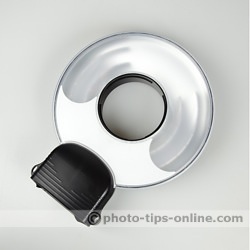 |
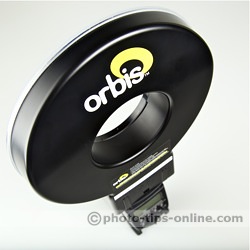 |
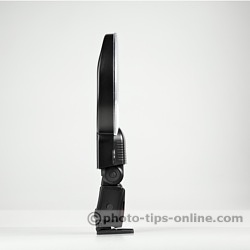 |
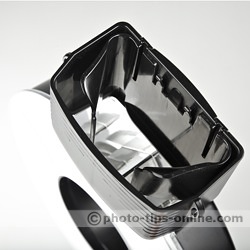 |
Orbis Ring Flash easily mounts on virtually any flash: just slide the flash head inside the adapter, and you are good to go. We tried it with three different flash heads, and the attachment worked almost equally well. In the following images, you can see Orbis attached to Nikon Speedlight SB-600 (small head), Canon Speedlite 580EX II (more common flash head size), and LumoPro LP160 (very wide flash head).
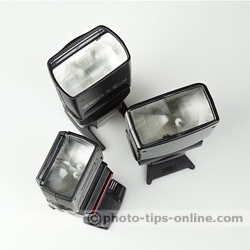 |
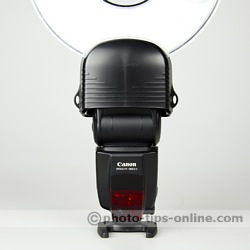 |
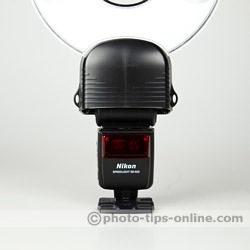 |
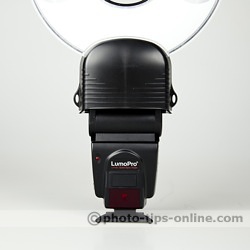 |
Orbis is designed in a way so it distributes the light around the lens quite evenly, creating a lighting effect very similar to what you get from real ring strobes. The bottom part of the ring, however, is still a bit "hotter" than the rest of it, but not significantly. The following images demonstrate the light distribution pattern.
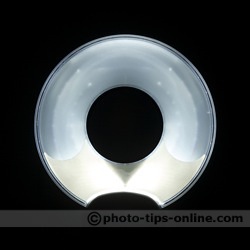 |
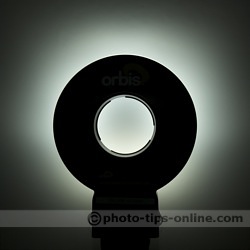 |
While Orbis adapter is generally color neutral and does not affect the color temperature of the flash light, there is some yellowish cast at the bottom part of the ring (as you can see in the above images), which can potentially cause a mixed color temperature situation in your images. It is something to watch out for, but in our tests, it hasn't really been an issue.
The light loss of Orbis Ring Flash is significant but reasonable for a light modifier of this nature. To the creators' credit, the internal components are highly reflective to minimize the light being lost. We advise using ISO 400 and up, which should not be a problem for any of the modern camera bodies.
We have also tested how the light is affected by the flash zoom settings. Orbis' design turned out to be pretty tolerant to the flash zoom changes, and the light quality was not changing a lot with the flash zoom adjustments. For better results, however, we recommend using flash zoom positions from 50mm and up, avoiding using wide-angle settings.
The image bellow is a sample shot taken with Orbis Ring Flash adapter from about 3 feet (1 meter) from the subject placed about 2 feet (0.65 meters) from the background.
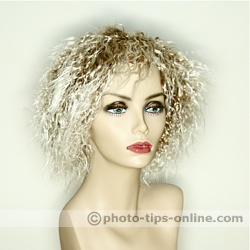 |
Ring flashes create donut-shaped catchlights. They can be fun to play with. In the following example, the camera and Orbis were set on a tripod and two shots were taken with the model standing in the left and right halves of the frame. The resulting image is the two images combined together. The ring-like catchlight adds an interesting twist to the photo.
 |
Orbis can also be used as an off-camera light diffuser similar to portable softboxes like LumiQuest Softbox III, Aurora MINI/MAX Softboxes, etc. The photo below is an example of such a use. (Orbis was about 3 feet/1 meter away from the subject.)
 |
The following images show Orbis side-by-side with Honl Photo traveller8 Softbox (left) and Rogue FlashBender Large Reflector (right).
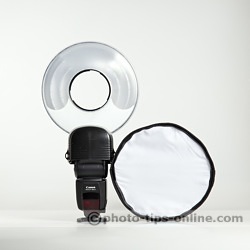 |
 |
Besides the more typical applications in portrait and fashion photography, Orbis Ring Flash can be successfully used in macro and product photography as a main or fill light.
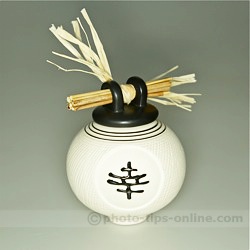 |
 |
Orbis Ring Flash comes with a protective carrying bag and a lanyard. The main purpose of the bag is to protect your Orbis from scratches. The lanyard allows you to carry the adapter on your neck or shoulder if that fits your workflow.
 |
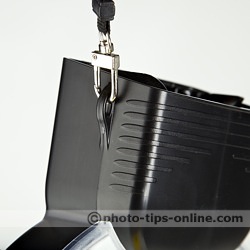 |
To conclude, Orbis Ring Flash adapter is a well-designed piece of photography gear. The one-fits-all design allows it to be used with virtually any flash on the market. The design requires the adapter and the flash to be hand-held or put on a special arm. This may turn some photographers away from this unit, but for the majority of the users, the hand-hold approach will not be a problem. The light Orbis produces is quite even, which results in beautiful "shadowless" images. When used off camera (not around the lens), the Orbis adapter can substitute a portable softbox for a hot shoe flash that extends its range of applications. While designed mainly for portraiture and fashion, Orbis can be very handy in macro and product photography, as well.